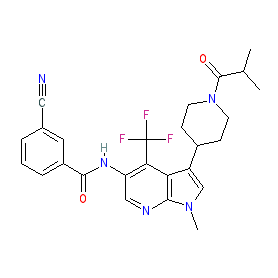GtoPdb is requesting financial support from commercial users. Please see our sustainability page for more information.
|
Synonyms: example 5 [WO2016046755A1]
Compound class:
Synthetic organic
Comment: This compound is reported as an orally active, inverse agonist of the nuclear hormone receptor RORγt (RORC2) [2]. RORγt is a drug target that is being expoited for the treatment of autoimmune conditions, as its inhibition reduces production of pro-inflammatory IL-17. The chemical structure is claimed as Example 5 in Pfizer's patent WO2016046755A1 [1].
Ligand Activity Visualisation ChartsThese are box plot that provide a unique visualisation, summarising all the activity data for a ligand taken from ChEMBL and GtoPdb across multiple targets and species. Click on a plot to see the median, interquartile range, low and high data points. A value of zero indicates that no data are available. A separate chart is created for each target, and where possible the algorithm tries to merge ChEMBL and GtoPdb targets by matching them on name and UniProt accession, for each available species. However, please note that inconsistency in naming of targets may lead to data for the same target being reported across multiple charts. ✖ |
|
|||||||||||||||||||||||||||||||||||
| Bioactivity Comments |
| Inverse agonist 66 reduces IL-17 production by human Th17 cells with an IC50 of 9.5 nM in vitro, and by mouse Th17 cells with an IC50 of 32 nM [2]. At the gene transcription level, compound 66 inhibits production of mRNAs from a number of genes that are regulated by RORγt (IL-17A , IL-17F, IL-22, IL-26, and IL-23R). Oral bioavailability was optimised (to overcome its low aqueous solubility) by formulating the compound as a spray-dried dispersion. In vivo, compound 66 demonstrated a dose dependent inhibition of ear swelling in the mouse imiquimod-induced skin inflammation model, which was mirrored by a dose-dependent reduction in IL-17A protein in ear tissue. |
| Selectivity at nuclear hormone receptors | ||||||||||||||||||||||||||||||||||
| Key to terms and symbols | Click column headers to sort | |||||||||||||||||||||||||||||||||
|
||||||||||||||||||||||||||||||||||







